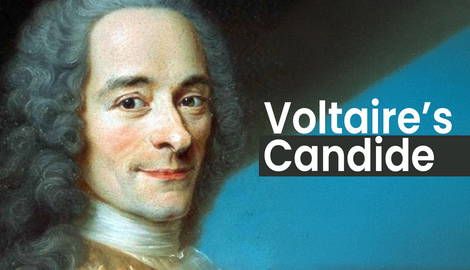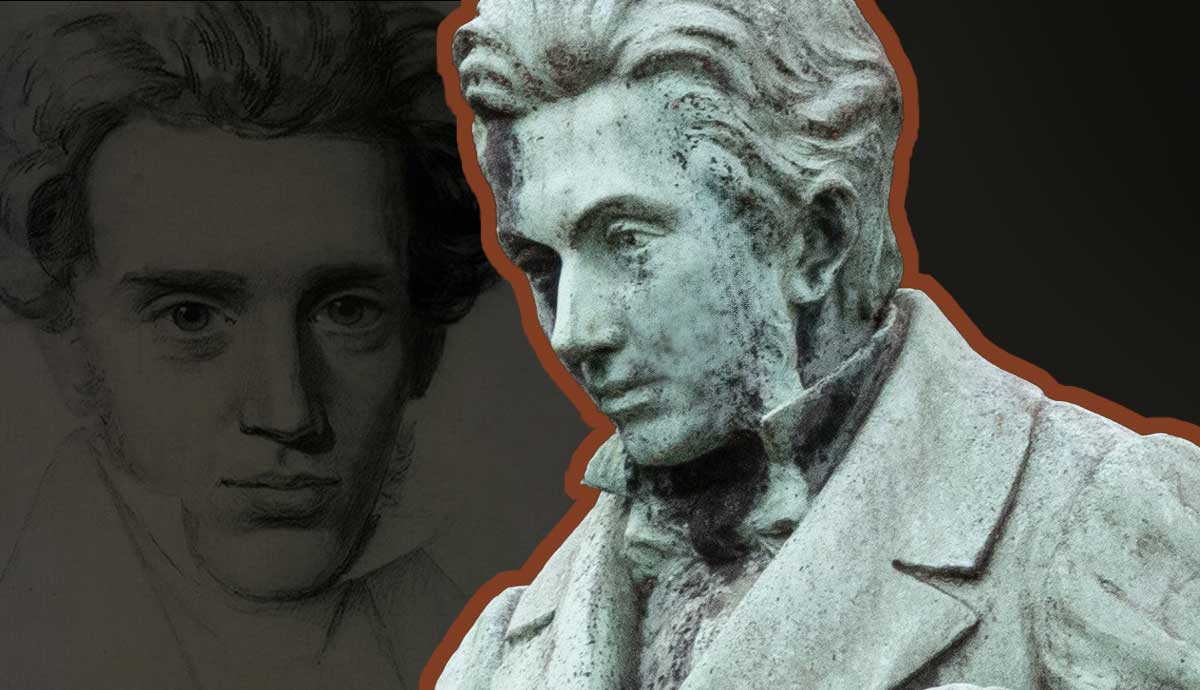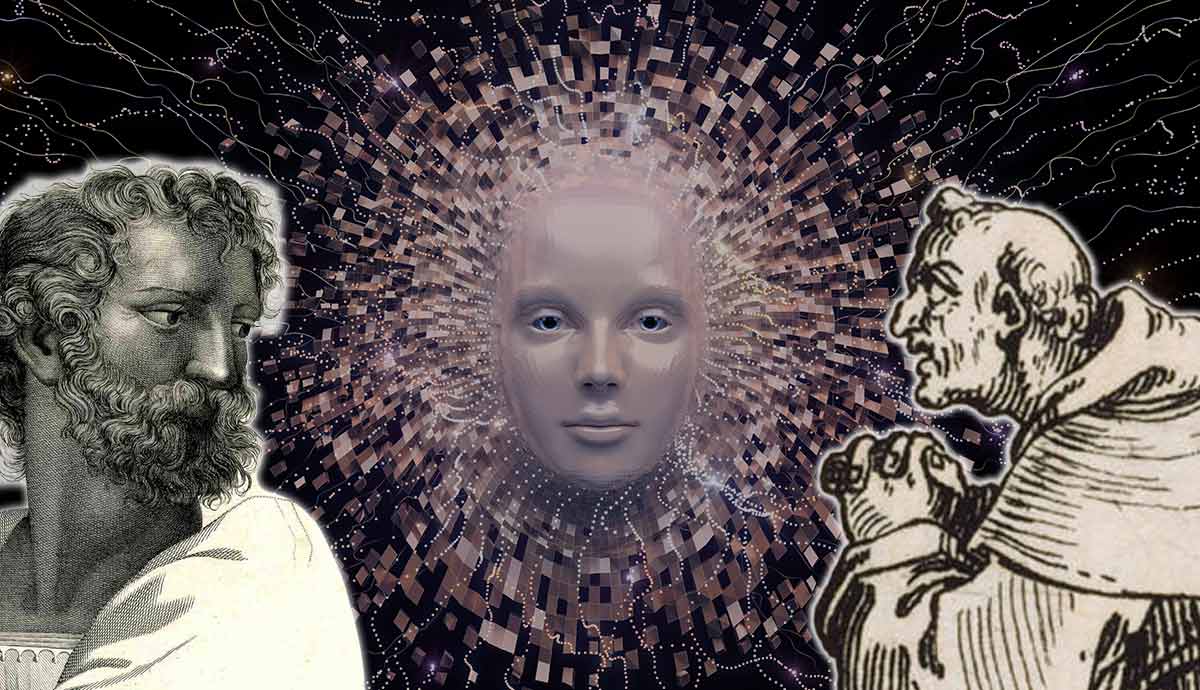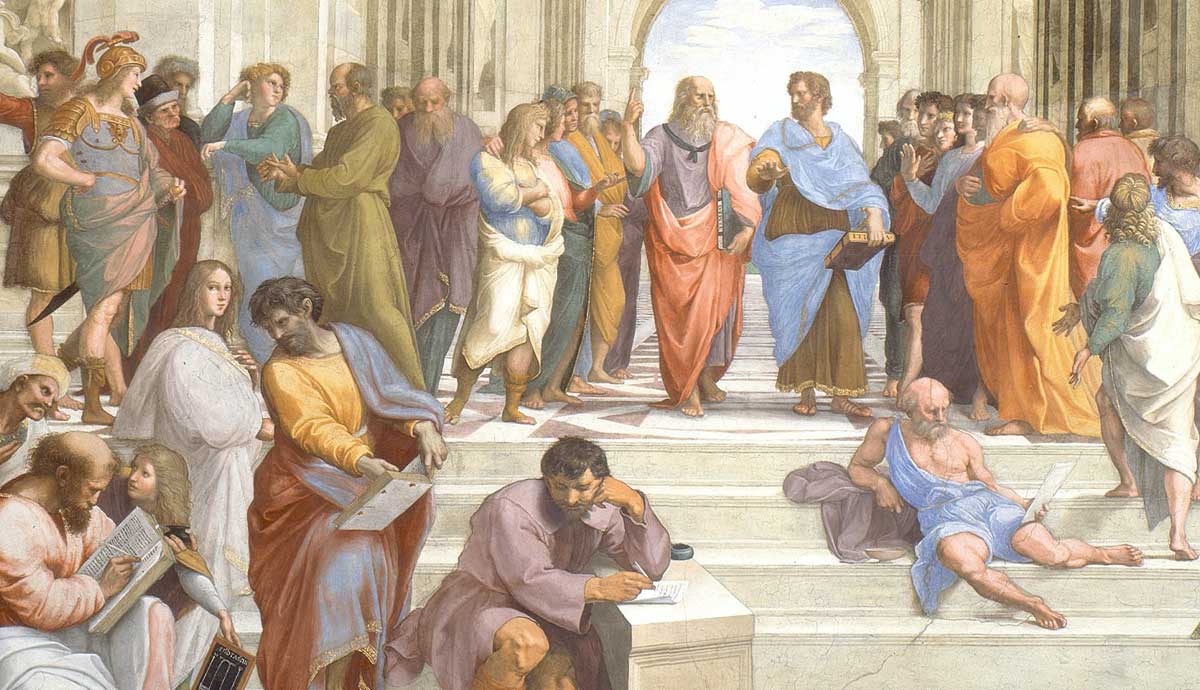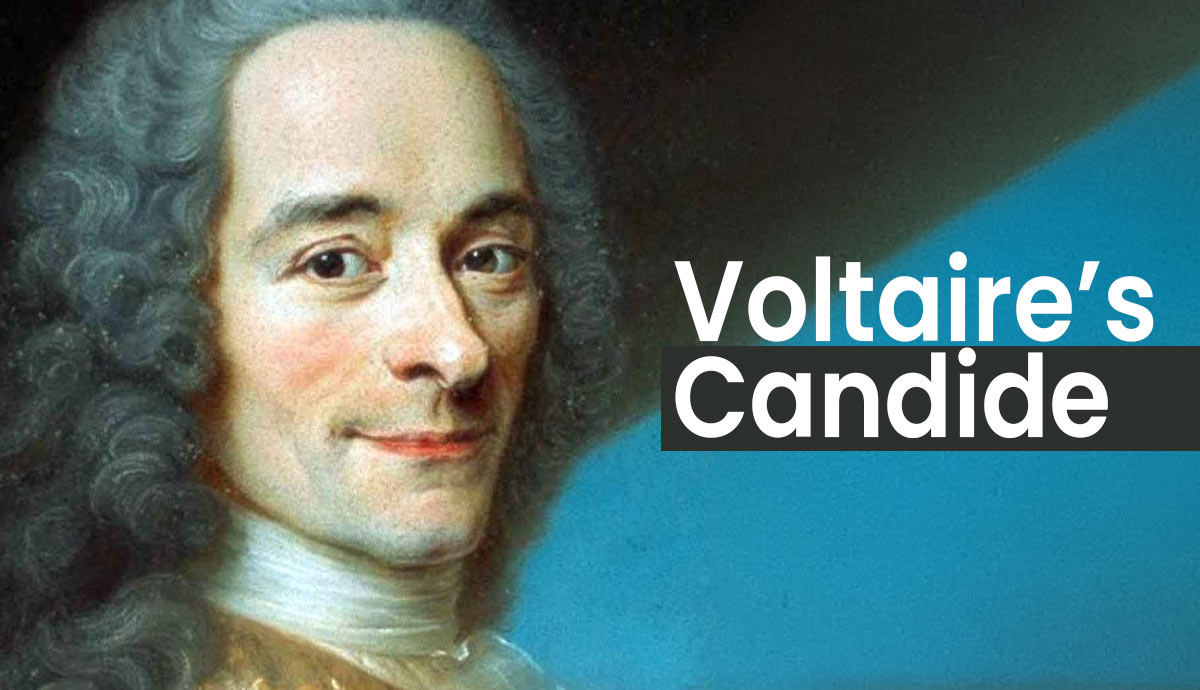
Born Francois-Marie Arouet in 1694, this celebrated playwright, poet, essayist, and philosopher reinvented himself as simply “Voltaire” in 1718. Candide is his most enduring work—a raw, rollicking, darkly ironic tale of a young man banished from his homeland. He suffers the most outrageous trials and misfortunes yet finds a way to survive. To paraphrase a famous movie title, one could call Voltaire’s masterpiece Candide or How to Stop Worrying about the Bombastic Absurdity of Life and Learn to Live with It.
Voltaire and the Age of Reason

In reality, “Optimism” is Candide’s subtitle, and it’s the first hint that Voltaire is putting the reader on. He was reacting with wry, winking irony to the prevailing 18th-century European sentiment of what historians call the Enlightenment. It was not so much an era as a broad revolution in intellectual thought that emerged first as a reaction against the dogmatic beliefs and rigid orthodoxy of the Roman Catholic Church—beliefs typically enforced by canon law and subject to ecclesiastic punishment.
The notorious example of the latter, of course, concerned the great 17th-century Italian scientist and astronomer Galileo, whose claim that the Earth rotated around the sun (the modern Copernican model) rather than opposite (the ancient Ptolemy model) would earn him a trip to a court of the Inquisition, where he was forced to recant under duress.
Still, Galileo’s devotion to scientific observation and empirical reason would become emblematic of the Enlightenment, most directly in the revelations wrought by Isaac Newton and his momentous studies of “Nature’s laws,” gravity first and foremost. Around the same time, influential social and political philosophers like Britain’s John Locke and David Hume, France’s Voltaire, and the Swiss-born Jean-Jacques Rousseau were charting a new course for “freethinking” ideas and norms away from the confines of Church-interpreted (and government-enforced) scripture.
It is no coincidence that the two defining political revolutions of the century were, first, the American War of Independence, followed by the French Revolution, both of which can be seen as manifesting the Enlightenment’s endorsement of individualist freedom and equality—the “rights of man”—including a citizen’s freedom from despotic monarchy and religion.
Earth-Shaking and Unreasonable Events

Given the bloody Reign of Terror that followed, that the French Revolution hardly lived up to its lofty goals of “Liberty, Equality and Fraternity” now appears as a prophetic vindication of Voltaire’s souring on the Enlightenment’s foundational beliefs that his Candide would burn at the stake. Thus, the dominant intellectual stance of the era was that the universe is orderly, logical, and governed by natural or mathematical laws (though we must discern them); for some thinkers, it can be metaphorically described as a boundless, machine-like mechanism (like a vast clock) that runs by itself—even if originally wound up and set by God.
What happened to set Voltaire’s own forward-looking philosophical clock backward? His biographers invariably point to the catastrophic Lisbon earthquake on November 1, 1755, an event literally and figuratively felt all through Europe. Modern estimates are that it was the equivalent of 8.5 on the Richter scale, included several aftershocks, and caused 50,000-60,000 deaths. As the temblor’s epicenter was off the coast, it uncorked a tsunami that crested at six-to-ten meters high when it slammed into and flooded the city.
Even worse (if that’s possible), soon after, a firestorm engulfed the remaining buildings and raged for five days. The horribly sad “kicker” in the disaster is that the quake struck Lisbon on the Catholic All Souls Day, meaning many thousands of its residents, young and old, were at mass in their local churches where multitudes met their end.
In 1756, Voltaire published a long, mournful poem on the Lisbon earthquake. In it, he calls out, “Come, ye philosophers, who cry ‘all is well.’ And contemplate the ruin of a world … Can it be from the author of the all good?” Of course, this is the eons-old cry of those religious-minded who believe in a divine being that created the world and looms over humanity. How can he (or she) allow or cause such suffering? And massacred at mass worshiping God, the almighty? Where was the logic and justice of the world in that? For Voltaire and many disconsolate others, if the universe is a clock, it must have a few screws loose.
The Seven Years War

Though not as singularly horrific, a prolonged event that evidently shook Voltaire was the death and destruction in Europe and elsewhere during the Seven Years’ War, which lasted from 1756 to 1763. This conflict was largely between colonial empires, with England and Prussia (Germany) eventually defeating the alliance of France, Austria, Russia, Sweden, and Saxony. The ultimate consequences were felt more in North America, where the British emerged as the leading colonial power while France largely withdrew.
Candide’s survival story unfolds against the background of this war, beginning in Chapter Two with the Bulgarian soldiers who trick the exiled young naïf into joining Frederick the Great’s Prussian army. Voltaire fires off an early satirical shot when the Prussians meet the French on the battlefield the next day. The kings of both armies have their brave troops singing the “Te Deum,” praising God, over their ensuing “heroic butchery” that will leave 30,000 dead.
Voltaire’s Voyages

On a personal level, Voltaire’s itinerant life—its twists, turns, and forcible detours—provides a road map of sorts for Candide’s wild transcontinental journeys. While finding success as a playwright in Paris, in 1718, he was sentenced to the notorious Bastille for a year after he was accused of writing libelous poems about the powerful Duke of Orleans. In 1726, as punishment for challenging a chevalier to a duel, he was exiled to England for two years.
His romantic fortunes had their own setbacks, the most profound being the death of his longtime love. By then, owing to his scandalous books allegedly critical of France or the Church, he had begun decades of a rootless existence in the capitals of Europe. While undoubtedly famous and wealthy in his later years, he no longer felt secure in Paris. In 1759, he finally settled in a large estate in the French mountain village of Ferney, near Switzerland. This abode was close enough to the border that he could make a fast getaway in case of more trouble with the French crown!
It’s in Voltaire’s first year at Ferney that he arranges for Candide to be anonymously published. As literary critics have long remarked, Voltaire’s principal theme considerably dims and dampens the bright intellectual outlook of the era. Specifically, he targets the sunny philosophies of the German Gottfried Leibniz, one of many important period thinkers who envisioned the world in terms of logic and rationality and that all things exist for a (divine) reason, most especially humanity.
Voltaire is sometimes accused of simplifying or even distorting Leibniz in the character of Pangloss—Candide’s glib, pedantic tutor whose simple explanation for everything is that humanity surely lives in the “best possible of all worlds,” principally because it was created by a benevolent God for humans.
Evicted From Eden

Pangloss (meaning “all tongue” in Latin) would even go so far as to say that there was a divine or metaphysical reason why innocent, candid (from the Latin for “pure”) Candide is booted out of his palatial home by his uncle, for kissing Cunégonde, his lovely, plump, and studious daughter. It will take the remaining 29 breezy chapters for Candide to finally reunite with his true love, but only after a string of dreadful misfortunes that will have him trek through three continents and across one ocean and back before finding a place to call home again. On his voyage, he will suffer seemingly every ill and injury known to man, most of them the consequence of the many-colored human varieties of cruelty, hate, prejudice, oppression, superstition, and ignorance—or just plain bad luck.
With a faithful servant, Cacambo, at his side, Candide will also be joined by a ragged crew of irregular companions, refugees all, who suffer as much or more than he does. The sorry lot includes a half-blind Pangloss, whose look-on-the-bright-side moralizing can’t spare him from the ravages of syphilis; Cunégonde, seemingly back from the dead after enduring a horrible “ravishing” by beastly Bulgarian soldiers; an old woman, once-wealthy, who tells the story of how she was trafficked in Morocco and sold into a harem; and Martin, a poor scholar whose weary pessimism arms Voltaire with a foil to prick Pangloss’ fatuous good cheer.
Prototype “Road” Novels

Immensely popular in its day, despite its blasphemous ridicule of religion, monarchy, war, and the human condition in general, contextually, Candide traveled in good company. It followed on the heels of several trailblazing novels (sometimes labeled “picaresque”) that also centered on the exploits of a hapless hero who hits the road, typically against his will, to cross paths with all manner of human behavior, good, bad, and fantastic.
It’s the sort of timeless template that fuels not only Jonathan Swift’s Gulliver’s Travels (1726) and Henry Fielding’s Tom Jones (1749) but also Miguel de Cervantes’ towering Don Quixote (1605/1615), which is usually credited as world literature’s first true novel.
Despite the litany of miseries endured by Candide and his vagabond band—hangings, floggings, and stabbings, oh my— elevated to ghoulish absurdity, Voltaire nevertheless sends his hero out on a high note, however tempered. Once reunited in Constantinople, Candide and company form a little community of equals working a farm, each doing his or her part. Pangloss, of course, argues that all things turned out for the best, and if Candide hadn’t gone through his hellacious odyssey as he did, he wouldn’t have found his way to the spot he ended up, eating pistachio nuts and reunited with Cunégonde (even if she’s not the fair maiden she once was).
Voltaire’s New Garden of Eden

Older and worse for wear, Candide is perhaps less sure than ever in his tutor’s a priori platitudes that “everything is for the best.” In a crooked, cockeyed world of trouble and tears, one must find his or her own place in it. Find a home, dig in, and keep busy. In his own words, he concludes, “We must cultivate our garden.”
